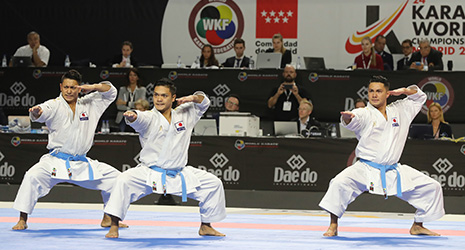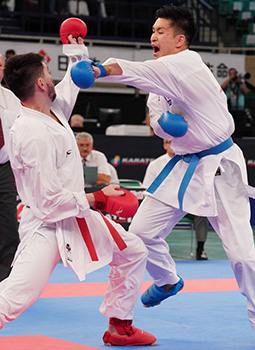INDEX
- English
- 日本語

The Japan men’s team’s gold medal winning performance in the kata (form) team event at the World Seniors in Spain, 2018 - English
- 日本語

Uekusa Ayumi (right) on her way to the silver medal in the female kumite (sparring) +68 kg class event at the World Seniors in Spain, 2018

Araga Ryutaro (right), men’s kumite event winner (-84 kg class) at an international championship in Tokyo, 2019 
Shimizu Kiyou, women’s kata event winner at the 2019 Japan Cup Karatedo in Tokyo
June 2020
Karate — Strengthening Mind and Body

Karate started in the Ryukyu Kingdom (Okinawa) as a defensive fighting technique, but from the 1920s, it spread across the whole of Japan and later the world as a martial art that places emphasis on the building of character. In 2021, karate will appear for the first time as an official sport at the Summer Olympics in Tokyo.

The Japanese martial art of karatedo (the “way of karate”) was born in the Ryukyu Kingdom (present-day Okinawa Prefecture) which existed for around 450 years from the fifteenth century. It is said that karate was formed as a fusion between the Ryukyu martial art of te (meaning hands; ti in Okinawan), which is a weaponless defensive technique that used arms and legs to strike, kick and throw the opponent, and martial arts introduced from China, with which the Ryukyu Kingdom had much active contact.
During the 1920s and 1930s, karate experts from Okinawa traveled to Tokyo and Osaka and popularized the art. Initially, the practice of karate was mainly based on kata (form)—sequences of techniques anticipating the movement of the opponent and representing strikes, kicks and blocks. But as karate spread, kumite (sparring) was devised as a practical person-to-person training, in which practitioners employ techniques against each other.
Karate was also influenced by the philosophy of judo, a martial art started by Kano Jigoro (1860–1938) in 1882 that enriches human character through the training of body and soul, before going on to develop as a martial art that places emphasis on character building. Funakoshi Gichin (1868–1957) studied karate in Okinawa, then did much to help spread karate across Japan from his base in Tokyo. He famously said, “Karate begins with politeness and finishes with politeness,” emphasizing the central importance in karate of showing respect.
After WWII, various schools of karate were established with differing kata, techniques and kumite rules. A large number of dojo (karate schools) were opened in Japan and overseas under these different lineages, and karate became familiar to people of all ages, from children to the elderly.

“It’s not easy to get better at the kumite and kata. That’s why I am drawn by karate’s depth,” says Shindo Mai, who attends a karate dojo in Tokyo with her sons aged 8 and 12. “Everyone is relaxed before and after the practice, but during the practice itself they focus intently on karate. That atmosphere in the dojo is another thing I like.”
Shindo started learning karate with her two sons four years ago while living in the Philippines for work. The teacher was from the Philippines and most of the dojo students were local people. At first, her goal was to start getting some exercise, but she was impressed by the impressive character of her teacher and soon became fascinated by karate. On her return to Japan, she quickly decided to continue her practice at a dojo near her home. Shindo says that her children are particularly enthusiastic about kumite and, although they are annoyed when they lose in a kumite bout, they never say they will quit.
“The young people in the dojo who have been practicing karate for many years are polite, sincere and full of confidence,” says Shindo. “Karate places value on the building of character rather than on winning or losing bouts and I feel children get a great deal from it.”
Japan’s main karate styles are affiliated to the Japan Karatedo Federation (JKF), which belongs to the World Karate Federation (WKF), an organization that currently has members from 200 countries and regions. The WKF has 60 million karate athletes and in total there are said to be over 130 million karate practitioners.

With karate’s internationalization, the level of competition in various countries has risen. At the 24th World Seniors Karate Championships, held in Spain in 2018, there were sixteen kata and kumite contests divided into gender- and weight-based categories. The winners came from Japan, Azerbaijan, Croatia, Germany, Iran, Italy, Poland, Serbia and Spain.
Karate has also, for the first time, been accepted as an official Olympic sport, and both kumite and kata will feature at the Tokyo Olympics next summer.
In kumite, the opposing athletes compete for points awarded when delivering scoring kicks or strikes using controlled technique on their opponent’s head or body. In kata, the athletes perform alone, winning points for the accuracy, strength, speed and rhythm of their techniques.
“The force and beautiful flow of top athletes’ kata is incredible,” says Shindo. “It’s amazing that human beings can move with such precision. When athletes from around the world gather for next year’s Olympics, I want to get a really good look at those top-level techniques.”
Born in the Ryukyu Kingdom, the “Way of Karate” continues to build character in Japan and around the world.

